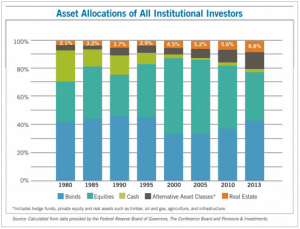The Fourth Major Asset Class
David Funk, a professor of mine and the former director of the Baker Program in Real Estate at Cornell University, recently published some interesting research into asset reallocation by institutional investors that more heavily favors commercial real estate. It is definitely worth a read:
Click here to read: ‘Real Estate Takes Its Place as the Fourth Asset Class‘
Worldwide, institutional investors (think private and public pension funds, endowments, insurance companies, etc) control nearly $70 trillion of capital, and traditionally have held their capital in cash, equities, and bonds. That tradition is changing. Institutional investors now see real estate as a viable investment vehicle, and are increasing their allocation to reflect that fact.

Frequently Asked Questions about Real Estate as the Fourth Major Asset Class
What is the traditional composition of institutional investment portfolios?
Traditionally, institutional investors allocated capital across three major asset classes: cash, equities, and bonds.
How has the role of real estate changed in institutional portfolios?
Real estate is now increasingly viewed as a viable investment vehicle by institutional investors. “In 1995, just 2.9% of institutional capital was invested in real estate… Today, 8.8% of institutional capital is in real estate.”
What target allocation are institutions now aiming for in real estate?
Institutional investors are targeting a 10% allocation to real estate.
How much new capital needs to be deployed to reach that target?
To meet the 10% target, institutions will need to invest “an additional $840 billion worldwide” into real estate.
What is the expected impact of this capital influx on the real estate market?
This increased investment is expected to put “downward pressure on cap rates and mortgage interest rates.”
Who conducted the research supporting these findings?
The research was conducted by David Funk, a professor and former director of the Baker Program in Real Estate at Cornell University.








